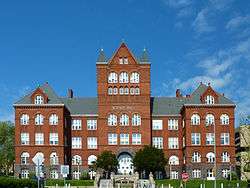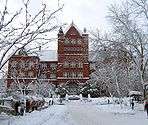University of Wisconsin Science Hall
University of Wisconsin Science Hall is a building on the campus of the University of Wisconsin–Madison. It is significant for its association with Charles R. Van Hise, "who led the Department of Mineralogy and Geology to national prominence" and then served as president of the university.[3] The building was constructed in 1888. It was declared a National Historic Landmark in 1993.[2][3][4][5][6][7]
University of Wisconsin Science Hall | |
 | |
  | |
| Location | 550 N. Park St., Madison, Wisconsin |
|---|---|
| Coordinates | 43°4′33″N 89°24′4″W |
| Built | 1888 |
| Architect | Henry C. Koch, Allan Conover |
| Architectural style | Romanesque |
| Part of | Bascom Hill Historic District (ID74000065) |
| NRHP reference No. | 93001616 |
| Significant dates | |
| Added to NRHP | November 4, 1993[1] |
| Designated NHL | November 4, 1993[2] |
Architecture
Science Hall is a U-shaped, three story building built in a Romanesque Revival motif. It was designed by Milwaukee architect Henry C. Koch and was later altered during construction by Allan D. Conover, a professor of civil engineering at the school. Rhyolite ashlar provides a bright red exterior. The main facade of the building is 205 feet (62 m) long and overlooks Park Street. It features a five-story tower with a hipped roof. Wings stretch to the west from the north and south. There are four three-story towers on each corner of the wings. A small, three-story round tower is found on each courtyard side of the two wings on the western extremity. Roofs were originally slate, but were replaced with asphalt shingles in 1992. A terra cotta hip roll decorates the towers below the roofs. There are sixteen brick chimneys throughout the building, all featuring a corbelled top.[3]
History
When completed in 1888, Science Hall was one of three instructional facilities at the University of Wisconsin. It originally hosted courses in geology, geography, physics, zoology, limnology, botany, anatomy, bacteriology, and medicine. The building helped to cement the university as one of the nation's leading geology schools. Science Hall was home to the first American courses in sedimentation, oceanography, and engineering geology. This was due in large part to its leading geologist, Charles R. Van Hise. Other prominent scientists associated with the building are geologist Charles Kenneth Leith, geomorphologist Armin K. Lobeck, physicist Robert W. Wood, physicist Earle M. Terry, physicist Edward Bennett, and anatomist Charles Russell Bardeen.[3]
Images
 Science Hall, December 2009
Science Hall, December 2009
See also
| Wikimedia Commons has media related to Science Hall, University of Wisconsin. |
References
- "National Register Information System". National Register of Historic Places. National Park Service. January 23, 2007.
- "University of Wisconsin Science Hall". National Historic Landmark summary listing. National Park Service. Retrieved 2007-12-30.
- Elizabeth L. Miller (September 30, 1992). "National Historic Landmark Nomination: University of Wisconsin Science Hall" (pdf). National Park Service. Cite journal requires
|journal=(help) and Accompanying 16 photos, exterior and interior, undated. (1.18 MB) Template:NHLS Archive index at the Wayback Machine - Clarence W. Olmstead (1987). Science Hall : The First Century. Dept. Of Geography, UW Madison. p. 41.
- "The History of Science Hall". The University of Wisconsin Geography Department. Retrieved 2010-07-31.
- "Chronology of Selected Events in Frank Lloyd Wright's Life". Frank Lloyd Wright Foundation. Retrieved 2010-08-01.
- "The UW-Madison's Science Hall, in all its red brick glory, is 120 years old this year". Retrieved 2010-08-01.
External links
- Science Hall in The Buildings of the University of Wisconsin